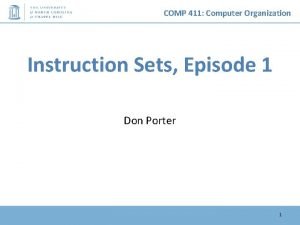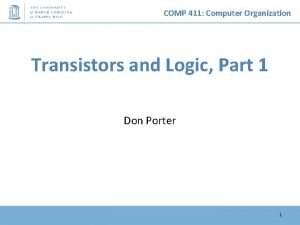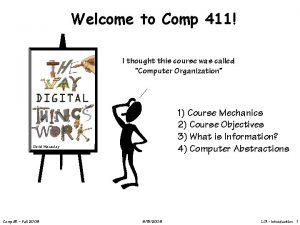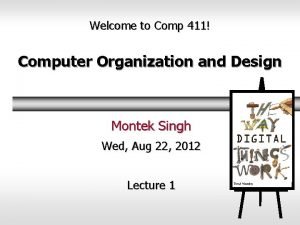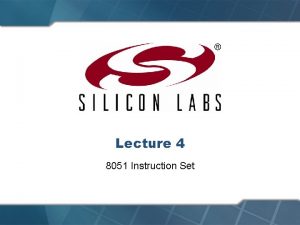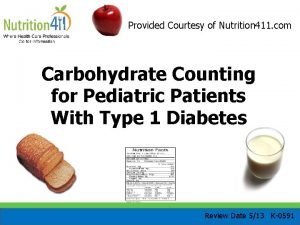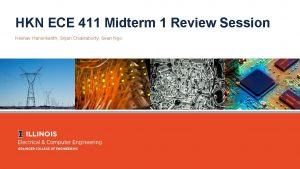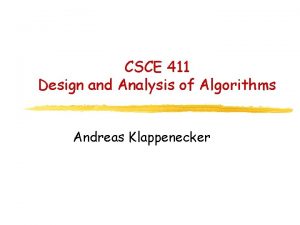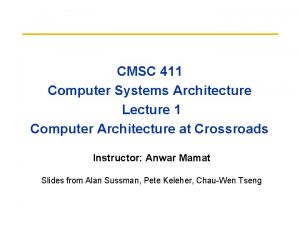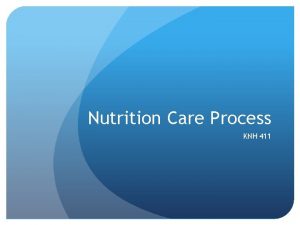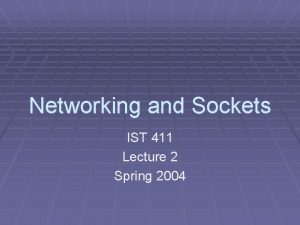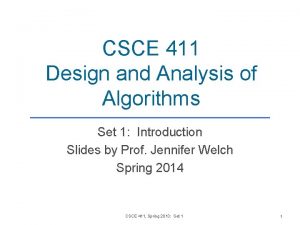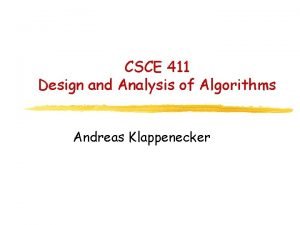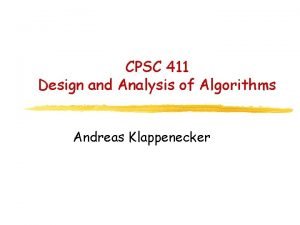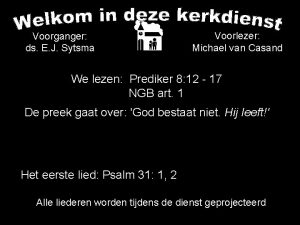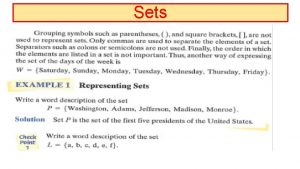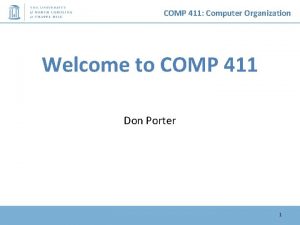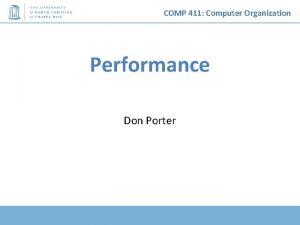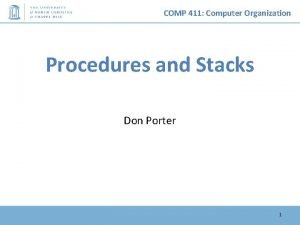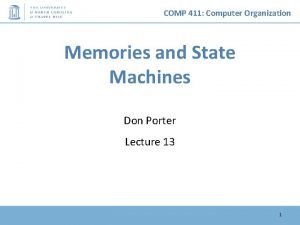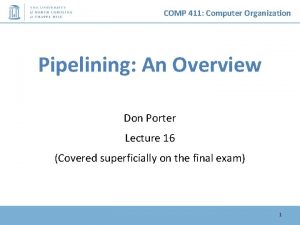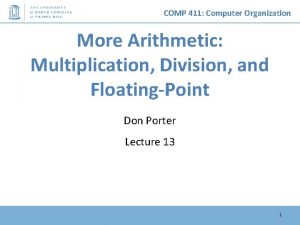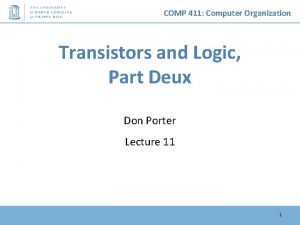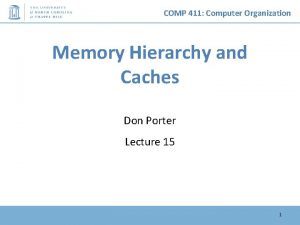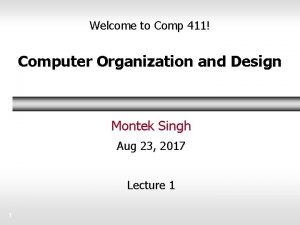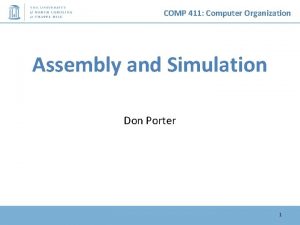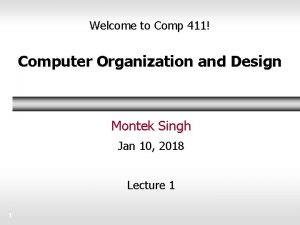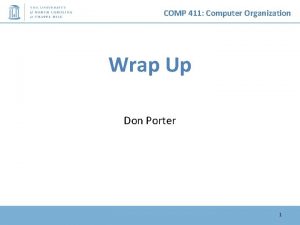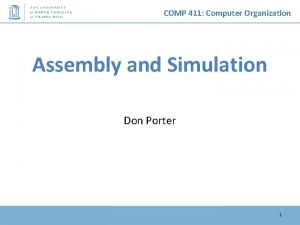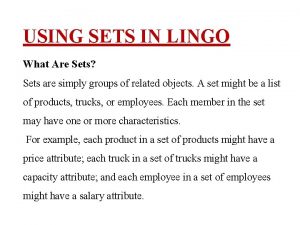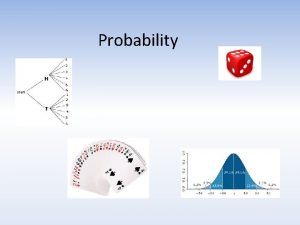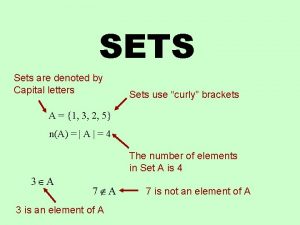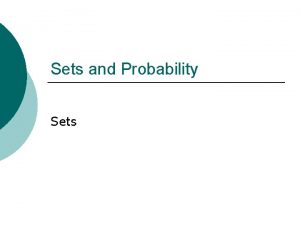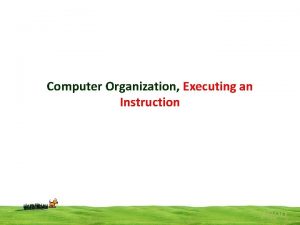COMP 411 Computer Organization Instruction Sets Episode 1




























- Slides: 28

COMP 411: Computer Organization Instruction Sets, Episode 1 Don Porter 1

COMP 411: Computer Organization Representing Instructions • Today’s topics – – von Neumann model of a computer Instruction set architecture MIPS instruction formats Some MIPS instructions • Reading – P&H textbook Ch. 2. 1 -2. 2, Ch. 2. 5 -2. 6 2

COMP 411: Computer Organization A General-Purpose Computer • The von Neumann Model – Many architectural models for a general-purpose computer have been explored – Most of today’s computers based on the model proposed by John von Neumann in the late 1940 s – Its major components are: Input/ Output Central Processing Unit Main Memory Central Processing Unit (CPU): Fetches, interprets, and executes a specified set of operations called Instructions. Memory: storage of N words of W bits each, where W is a fixed architectural parameter, and N can be expanded to meet needs. I/O: Devices for communicating with the outside world. 3

COMP 411: Computer Organization Instructions and Programs • What are instructions? – the words of a computer’s language • Instruction Set – the full vocabulary • Stored Program Concept – The idea that instructions and data of many types can be stored in memory as numbers, leading to the stored program computer • Distinct from “application-specific” hardware, which is “hardwired” to perform “fixed-function” processing on inputs • Distinct from punched tape computers (e. g. , looms) where instructions were not stored, but streamed in one at a time 4

COMP 411: Computer Organization Anatomy of an Instruction • An instruction is a primitive operation – Instructions specify an operation and its operands (the necessary variables to perform the operation) – Types of operands: immediate, source, and destination Operation $X is a convention to denote the contents of a “register”, which is a location inside the CPU. In contrast, immediate operands indicate the value itself add $t 0, $t 1, $t 2 Operands (variables, arguments, etc. ) Source Operands Destination Operand addi $t 0, $t 1, 1 5 Immediate Operand

COMP 411: Computer Organization Meaning of an Instruction • • Operations are abbreviated into opcodes (1 -4 letters) Instructions are specified with a very regular syntax – First an opcode followed by arguments – Usually (but not always) the destination is next, then source – Why this order? Arbitrary… • … but analogous to high-level language like Java or C add $t 0, $t 1, $t 2 implies (int) t 0 = t 1 + t 2 6 The instruction syntax provides operands in the same order as you would expect in a statement from a high level language.

COMP 411: Computer Organization Being the Machine! • Instruction sequence – Instructions are executed sequentially from a list … • … unless some special instructions alter this flow – Instructions execute one after another • therefore, results of all previous instructions have been computed Variables Instructions add $t 0, $t 1 What is this program doing? add $t 0, $t 0 sub $t 1, $t 0, $t 1 7 $t 0: 0 1224 48 $t 1: 6 42 $t 2: 8 $t 3: 10

COMP 411: Computer Organization What did this machine do? • Let’s repeat the simulation, this time using unknowns – CLASS: What is this machine doing? • Knowing what the program does allows us to write down its specification, and give it a meaningful name Instructions times 7: Variables add $t 0, $t 1 $t 0: w 2 x 4 x 8 x add $t 0, $t 0 $t 1: x add $t 0, $t 0 $t 2: y sub $t 1, $t 0, $t 1 $t 3: z 7 x 8

COMP 411: Computer Organization Looping the Flow • Need something to change the instruction flow – “go back” to the beginning – a jump instruction with opcode ‘j’ • • • the operand refers to a label of some other instruction for now, this is a text label you assign to an instruction in reality, the text label becomes a numerical address Instructions times 7: Variables add $t 0, $t 1 $t 0: w 8 x 56 x 392 x $t 1: x 7 x 49 x 343 x add $t 0, $t 0 $t 2: y sub $t 1, $t 0, $t 1 $t 3: z add $t 0, $t 0 j times 7 An infinite loop

COMP 411: Computer Organization Open Questions in our Simple Model • We will answer the following questions next – – – WHERE are INSTRUCTIONS stored? HOW are instructions represented? WHERE are VARIABLES stored? How are labels associated with particular instructions? How do you access more complicated variable types: • • • Arrays? Structures? Objects? – Where does a program start executing? – How does it stop? 10

COMP 411: Computer Organization The Stored-Program Computer • The von Neumann model: – Instructions and Data stored in a common memory (“main memory”) – Sequential semantics: All instructions execute sequentially (or at least appear sequential to the programmer) Main Memory Key idea: Memory holds not only data, but coded instructions that make up a program. ã instruction Central Processing Unit CPU fetches and executes instructions from memory. . . • The CPU is a hardware interpreter • Program IS simply data for this interpreter data • Main memory: Single expandable resource pool - constrains both data and program size - don’t need to make separate decisions of how large of a program or data memory to buy 11

COMP 411: Computer Organization registers Anatomy of a von Neumann Computer control Data Path address Control Unit status data address instructions MEMORY +1 Register 0 PC 1101000111011 R 2+R 3 Register 1 • INSTRUCTIONS coded in binary Register 31 “Register File” • PROGRAM COUNTER or PC: Address of next instruction to be executed • Control Unit has circuitry inside to translate instructions into control signals for data path 12

COMP 411: Computer Organization Instruction Set Architecture (ISA) • Definition: – The part of the computer architecture related to programming, including the native data types, instructions, registers, addressing modes, memory architecture, interrupt and exception handling, and external I/O – An ISA includes a specification of the set of opcodes (machine language), and the native commands implemented by a particular processor 13

COMP 411: Computer Organization Instruction Set Architecture (ISA) • Encoding of instructions raises interesting choices. . . – Tradeoffs: performance, compactness, programmability – Complexity • How many different instructions? What level operations? – Level of support for particular software operations: array indexing, procedure calls, “polynomial evaluate”, etc. • “Reduced Instruction Set Computer” (RISC) philosophy: simple instructions, optimized for speed – Uniformity • Should different instructions be same size? • Take the same amount of time to execute? • Trend favors uniformity simplicity, speed, cost/power • Mix of Engineering & Art. . . – Trial (by simulation) is our best technique for making choices! Our representative example: the MIPS architecture

COMP 411: Computer Organization – Memory is distinct from data path – Registers are in data path – Program is stored in memory – Control unit fetches instructions from memory – Control unit tells data path what to do – Data can be moved from memory to registers, or from registers to memory – All data processing (e. g. , arithmetic) takes place within the data path 15 registers • A few things to note: The big picture control Data Path address Control Unit status data address MEMORY instructions

COMP 411: Computer Organization MIPS Programming Model a representative simple RISC machine Main Memory In Comp 411 we’ll use a clean and sufficient subset of the 00 MIPS-32 core Instruction set. Addresses Processor State (inside the CPU) PC 31 r 0 r 1 r 2. . . 000000. . 0 32 bit “words” r 31 General Registers: A small scratchpad of frequently used or temporary variables 0 0 3 2 1 0 4 32 bit “words” 8 (4 bytes) 16 20 next instruction Fetch/Execute loop: • fetch Mem[PC] • PC = PC + 4† • execute fetched instruction (may change PC!) • repeat! †MIPS uses byte memory addresses. However, each instruction is 32 -bits wide, and *must* be aligned on a multiple of 4 (word) address. Each word contains four 8 -bit bytes. Addresses of consecutive instructions (words) differ by 4. 16

COMP 411: Computer Organization Some MIPS Memory Nits • Memory locations are 32 bits wide – BUT, they are addressable in differentsized chunks short 2 – 8 -bit chunks (bytes) byte 3 byte 2 – 16 -bit chunks (shorts) Addr – 32 -bit chunks (words) 2 0: 3 – 64 -bit chunks (longs/double) 6 4: 7 31 30 29 … 8: • We also frequently need 12: access to individual bits! (Instructions help w/ this) • Every BYTE has a unique address (MIPS is a byte-addressable machine) • Every instruction is one word 17 short 0 byte 1 byte 0 1 … 43210 0 5 4 12 10 9 8 15 14 13 12 long 0 long 8

COMP 411: Computer Organization MIPS Register Nits • There are 32 named registers [$0, $1, …. $31] • The operands of all ALU instructions are registers – This means to operate on a variables in memory you must: • Load the value/values from memory into a register • Perform the instruction • Store the result back into memory – Going to and from memory can be expensive • (4 x to 20 x slower than operating on a register) – Net effect: Keep variables in registers as much as possible! • Special purpose and conventions – 2 registers have specific “side-effects” • (ex: $0 always contains the value ‘ 0’… more later) – 4 registers dedicated to specific tasks by convention – 26 available for general use, but constrained by convention 18

COMP 411: Computer Organization MIPS Instruction Formats • All MIPS instructions fit into a single 32 -bit word • Every instruction includes various “fields”: – a 6 -bit operation or “OPCODE” • specifies which operation to execute (fewer than 64) – up to three 5 -bit OPERAND fields • each specifies a register (one of 32) as source/destination – embedded constants • also called “literals” or “immediates” • 16 -bits, 5 -bits or 26 -bits long • sometimes treated as signed values, sometimes unsigned • There are three basic instruction formats: • R-type, 3 register operands (2 sources, destination) • I-type, 2 register operands, 16 bit constant • J-type, no register operands, 26 -bit constant OP rs rt OP rd shamt func 16 -bit constant 26 -bit constant

COMP 411: Computer Organization MIPS ALU Operations Sample coded operation: ADD instruction R-type: 0 0 0 0 1 1 0 0 1 0 1 0 0 0 0 0 op = 0 x 00 dictating an ALU function func = 0 x 20 rd = 10 dictating an Reg[10] add rt = 9 destination unused Reg[9] fields are source set to ‘ 0’ What we prefer to write: add $10, $11, $9 (“assembly language”) rs = 11 Reg[11] source The convention with MIPS assembly language is to specify the destination operand first, followed by source operands. add rd, rs, rt: Reg[rd] = Reg[rs] + Reg[rt] “Add the contents of rs to the contents of rt; store the result in rd” 20 References to register contents are prefixed by a “$” to distinguish them from constants or memory addresses Similar instructions for other ALU operations: arithmetic: add, sub, addu, subu compare: slt, sltu logical: and, or, xor, nor shift: sll, sra, sllv, srav, srlv

COMP 411: Computer Organization Shift operations • Shifting is a common operation – – – applied to groups of bits used for alignment used for “short cut” arithmetic operations • X << 1 is often the same as 2*X • X >> 1 can be the same as X/2 • For example: – X = 2010 = 000101002 – Left Shift: • (X << 1) = 001010002 = 4010 – Right Shift: • (X >> 1) = 000010102 = 1010 – Signed or “Arithmetic” Right Shift: • (-X >>> 1) = (111011002 >>> 1) = 111101102 = -1010

COMP 411: Computer Organization MIPS Shift Operations Sample coded operation: SHIFT LOGICAL LEFT instruction R-type: 0 0 0 0 1 0 0 0 0 0 0 op = 0 x 00 dictating an ALU function unused set to ‘ 0’ rd = 2 Reg[2] rt = 2 destination Reg[2] source Assembly: sll $2, 4 sll rd, rt, shamt: Reg[rd] = Reg[rt] << shamt “Shift the contents of rt to the left by shamt; store the result in rd” 22 func = 0 x 00 dictating an sll shamt = 4 dictates a shift of 4 -bits

COMP 411: Computer Organization MIPS Shift Operations Sample coded operation: SLLV (SLL Variable) R-type: 0 0 0 0 1 0 0 0 1 0 0 op = 0 x 00 dictating an ALU function rd = 2 Reg[2] rt = 2 destination Reg[2] source shift amount in rs Different flavor: Shift amount is not in instruction, but in a register func = 0 x 04 dictating an sllv unused set to ‘ 0’ This is peculiar syntax for MIPS, in this ALU instruction the rt operand precedes the rs operand. Usually, it’s the other way around Assembly: sllv $2, $8 sllv rd, rt, rs: Reg[rd] = Reg[rt] << Reg[rs] “Shift the contents of rt left by the contents of rs; store the result in rd” 23

COMP 411: Computer Organization MIPS ALU Operations with Immediate addi instruction: adds register contents, signed-constant: I-type: 0 0 1 0 1 0 0 1 1 1 1 0 1 OP = 0 x 08, dictating addi rs = 11, Reg[11] source rt = 9, Reg[9] destination constant field, indicating -3 as second operand (sign-extended!) Symbolic version: addi $9, $11, -3 Similar instructions for other ALU operations: addi rt, rs, imm: Reg[rt] = Reg[rs] + sxt(imm) “Add the contents of rs to const; store result in rt” 24 arithmetic: addi, addiu compare: slti, sltiu logical: andi, ori, xori, lui Immediate values are sign-extended for arithmetic and compare operations, but not for logical operations.

COMP 411: Computer Organization Why Built-in Constants? (Immediate) • Where are constants/immediates useful? – SMALL constants used frequently (50% of operands) • In a C compiler (gcc) 52% of ALU operations use a constant • In a circuit simulator (spice) 69% involve constants • e. g. , B = B + 1; C = W & 0 x 00 ff; A = B + 0; • Examples: addi slti andi ori $29, $8, $29, 25 $29, 4 $18, 10 $29, 6 $29, 4

COMP 411: Computer Organization First MIPS Program (fragment) • Suppose you want to compute the expression: f = (g + h) – (i + j) • where variables f, g, h, i, and j are assigned to registers $16, $17, $18, $19, and $20 respectively • what is the MIPS assembly code? add $8, $17, $18 add $9, $19, $20 sub $16, $8, $9 # (g + h) # (i + j) # f = (g + h) – (i + j) – Questions to answer: • How did these variables come to reside in registers? • Answer: We need more instructions which allow data to be explicitly loaded from memory to registers, and stored from registers to memory 26

COMP 411: Computer Organization MIPS Register Usage Conventions • Some MIPS registers assigned to specific uses – by convention, so programmers can combine code pieces • will cover the convention later – $0 is hard-wired to the value 0

COMP 411: Computer Organization Continue next lecture… • More instructions – – – accessing memory branches and jumps larger constants multiply, divide etc. 28
 Comp 411
Comp 411 Comp 411
Comp 411 Comp 411 unc
Comp 411 unc Comp 411
Comp 411 Instruction set architecture in computer organization
Instruction set architecture in computer organization Computer architecture attributes
Computer architecture attributes Swap instruction in 8051 example
Swap instruction in 8051 example Process organization in computer organization
Process organization in computer organization What is markov analysis
What is markov analysis Basic structure of a computer system
Basic structure of a computer system Difference between architecture and organization
Difference between architecture and organization Complete computer description in computer organization
Complete computer description in computer organization Flowchart for memory reference instructions
Flowchart for memory reference instructions Individualized instruction vs differentiated instruction
Individualized instruction vs differentiated instruction Indirect instruction definition
Indirect instruction definition Nutrition 411
Nutrition 411 Mgt 411
Mgt 411 Ece 411
Ece 411 Csce 411
Csce 411 Cmsc submit server
Cmsc submit server Nutrition care process
Nutrition care process Nutritional assessment definition
Nutritional assessment definition Ist 411
Ist 411 Csce 411
Csce 411 Csce 411
Csce 411 Cpsc 411
Cpsc 411 Csc 411
Csc 411 411 disability disclosure
411 disability disclosure Opwekking 411 tekst
Opwekking 411 tekst
